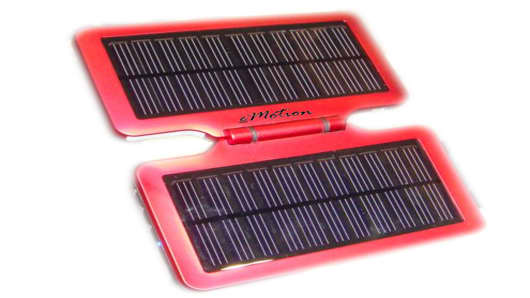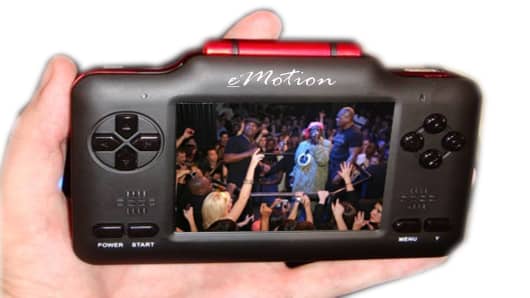The eMotion Solar (5.5. x 3 x 1 inch) opens like a book, revealing two broad, black, shiny solar panels. To charge this machine, you just stick it where the sun does shine, like on a windowsill. Even on an overcast day, its little Recharge indicator light pops on. The battery recharges after 12 to 15 hours of exposure to sunlight, which the company says is enough for nine hours of music playback. Then again, if you’re in direct sun, you don’t even care about the battery; sunlight alone is enough to drive music playback.
The Eco Player, on the other hand, has a built-in crank on the back, no more obtrusive than a belt clip. The winding turns out to be kind of fun, thanks to just the right amount of resistance. According to the company, one minute of winding generates enough power for 40 minutes of music playback. A fully charged battery can play music for 20 hours, or video for 10.
Now, let’s be real here; media players aren’t exactly high on the greenhouse-gases Most Wanted list. Every little bit helps, of course, but the snows of Mount Kilimanjaro haven’t melted because you’ve been listening to too much heavy metal on your iPod.
Fortunately, self-powered players have other charms. They’re indispensable for backpackers, campers and anyone else who plans to be away from a power outlet for a while; indeed, both the Solar and the Eco Player are ruggedly built, with rubberized nonscratchable surfaces.
There’s a secret bonus feature, too: you can use these players to recharge other portable gadgets. Yes, these players can drag less environmentally enlightened electronics off the grid along with them.
To make this work, you connect your secondary gadget to the eco-player’s U.S.B. jack using the appropriate adapter cable. The eMotion Solar comes with 12 such tips, most intended for cellphones and things that can be charged from a U.S.B. jack (including BlackBerrys, Treos and even iPods). The Eco Player, on the other hand, recharges only cellphones (it comes with five cable tips), and only while you’re cranking.
One final attraction, even for nonhikers: these machines are among the very first products to address the rarely discussed Accessory Fatigue Syndrome.
Every time you buy a gadget — a phone, camera, music player — you’re not just adding one item to the list of things you have to pack, track and care for; you’re adding two or three. Another power cord, another cradle and another set of earbuds. Own several of these things, and it gets exhausting to keep them organized and accounted for.
These two new eco-players, however, can be completely self-contained. Both come with earbuds and a secondary charging method (the eMotion Solar has a traditional power adapter; either player can charge from a computer’s U.S.B. jack) — but none of that is required. You can toss the player into your bag by itself, without any cables or accessories; you can power it from the sun or the crank, and, in a pinch, listen through the built-in speakers. And you’re flooded with a strange sort of techno-relief.
All right, now you know about these players’ astounding energy-saving features. How do they fare as music and video players?
Um, well ... hey, did I mention that they can recharge your cellphone?
All right, let’s just admit it: next to the highly refined software and hardware design of the iPod and the Zune, these players look positively Neanderthal. The menus are crude and claustrophobic; on both players, messages appear in the Courier-ish font of an I.B.M. Selectric; and there’s no scroll wheel or touch pad for navigation. You walk through lists by pressing up/down arrow buttons.




